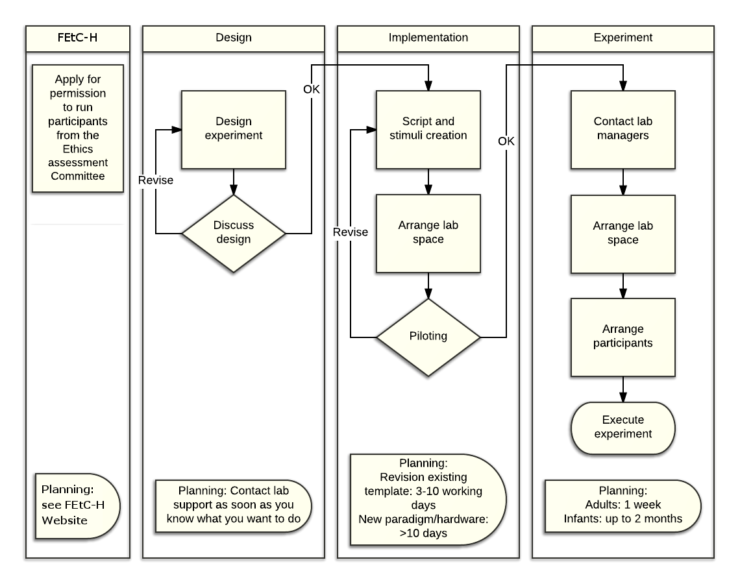Planning an Experiment
Introduction
This page contains a guide for doing research in the ILS Labs. Please read it carefully.
If you haven’t already, please read the Introduction to ILS Labs first.
Step-by-step guide for planning an experiment
Think about which experimental paradigm you are going to use and discuss it with your supervisor.
Feel free to browse the experiments template page for inspiration. On this page, you can find links to various commonly used experimental paradigms.
Infant Experiments
For infant experiments, talk to Desiree Capel at the very beginning stage of designing an experiment. She can give you suggestions about detailed practical issues in infant testing, and what parameters you need to decide on when designing infant experiments (and possible complications of these parameters). This will help you to avoid infeasible paradigms and to reduce noise in the data, and prevent a high drop-out rate.
You are expected to attend the weekly babylab user meetings if you’re doing an infant experiment.
Eye-tracking Experiments
For eye-tracking experiments, contact Iris Mulders. She will tutor you in how to use the equipment, and guide you to the appropriate experiment templates and documentation.
You are expected to attend the monthly eye-tracking lab user meeting while working with eye-tracking.
EEG Experiments/ other bio measures
For experiments using EEG or other bio measures, contact Marijn Struiksma. She will guide you to the appropriate experiment templates and documentation, and set you up with someone who can tutor you in using the equipment.
You are expected to attend the monthly biolab user meeting while working with biomeasures.
The possibility exists that you did not find a suitable template on the experiments template page.
If you have a clear idea of your experiment paradigm, fill out the software development request form. If it strongly resembles an existing template, please let us know as well, so we can revise the script and we can all progress faster.
If you do not have a clear idea of how your experiment could be implemented, or which ZEP experiment template comes closes to what you need, contact Maarten Duijndam and/or Ben Bonfil; they will be able to help you choose which template is closest to your desired experiment.
Bottom line: talk to lab support as soon as you have some clarity on what you want to do so they can plan the work.
Your experiment needs ethical approval before participants can be recruited. For the possible time paths, see the flowchart. For more detailed information about how and when to submit your study for review, see the FEtC-H website.
After explaining the experimental design to Maarten and/or Ben, you can start working on your test stimuli or sound stimuli, as the programming of the experiment will take some time.
Once you have your stimuli ready and Maarten/Ben has the experiment script ready, you can start piloting your experiment. First run a technical pilot:
- Reserve lab space.
- Some quick tips on working with the Linux operating system in the lab will be shown to you when you log in there.
- If your experiment is time-sensitive, familiarize yourself with running your experiment locally. See the instructions on how to properly run your ZEP experiment in the lab and ask lab support for help.
- Check whether the experiment runs in the way that you want.
Check the randomization, conditions, volume, inter-stimulus interval, visual stimuli, etc.
Be patient to let the whole experiment finish completely, so that you know how long it takes, and how a participant feels in the experiment, and to enable you to check the complete result file. - Carefully check the output to see whether all the information that you need is printed in the output file(s), such as condition, trial number, participant number, participant name, sound file, answer given by participant, reaction time, or any other information that you may need in the result files.
Next, run a behavioral pilot with pilot participants:
- Pilot your experiment on a few friends/yourself; observe their behavior, ask them how they feel doing the experiment. You may discover at this point that people do not perform the task the way you expected them to.
- Analyze the results as you intend to do for the real experiment.
Mistakes in the design or implementation may surface at this point.
Consult with your supervisor if you’re a BA/MA student, consult statistician/methodologist Kirsten Schutter if you’re a PhD student or staff member.
If everything is fine, you can proceed to real experimentation. Make sure you are familiar with the procedures of properly running your ZEP experiment in the lab.
Adult participants
For experiments involving adult participants, you will first need to secure funding to pay them. Don’t forget to prepare a reimbursement form; take a look at the template signing list.
To recruit adult participants, follow the instructions in the how-to Recruiting Participants. Do this a week before you plan to run your experiment.
Also make sure to reserve lab time for adult experiments.
Infant experiments
For infant experiments, contact Desiree Capel and tell her how many participants you need, and other requirements for the participants.
Summary
This flowchart summarizes the process described above.
Go to whom for what
- Maarten Duijndam and Ben Bonfil:
- Programming of your experiment
- Revision of your experiment scripts
- Technical support
- Linux/Windows support
- Iris Mulders:
- Recruiting adult participants
- Eye-tracking experiments
- Eye-tracking data analysis training for PhD students and staff
- Marijn Struiksma:
- EEG experiments
- Experiments involving other bio measures (GSR etc)
- Desiree Capel:
- Recruiting infant participants
- Availability of the baby lab and the flex lab
- Infant surveys (Anamnese CDI, PPVT, ect)
- Kirsten Schutter:
- Experiment design
- Statistics – both before and after running your experiment, for PhD students and staff


